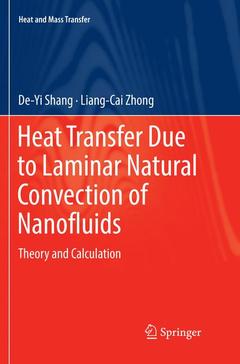Heat Transfer Due to Laminar Natural Convection of Nanofluids, Softcover reprint of the original 1st ed. 2019 Theory and Calculation Heat and Mass Transfer Series
Auteurs : Shang De-Yi, Zhong Liang-Cai

This book presents a theoretical study of heat transfer due to laminar natural convection of nanofluids, using Al2O3-water nanofluid as an example. An innovative method of similarity transformation of velocity fields on laminar boundary layers is applied for the development of a mathematical governing model of natural convection with actual nanofluids, and a novel model of the nanofluid's variable thermophysical properties is derived by a mathematical analysis based on the developed model of variable physical properties of fluids combined with the model of the nanofluid's thermal conductivity and viscosity. Based on these, the physical property factors of nanofluids are produced, which leads to a simultaneous solution for deep investigations of hydrodynamics and heat transfer of nanofluid's natural convection.
The book also proposes novel predictive formulae for the evaluation of heat transfer of Al2O3-water nanofluid?s natural convection. The formulae have reliable theoretical and practical value because they are developed by rigorous theoretical analysis of heat transfer combined with full consideration of the effects of the temperature-dependent physical properties of nanofluids and the nanoparticle shape factor and concentration, as well as variations of fluid boundary temperatures. The conversion factors proposed help to turn the heat transfer coefficient and rate of fluid natural convection into those of nanofluid natural convection. Furthermore, several calculation examples are provided to demonstrate the heat transfer application of the proposed predictive formulae.
Introduction.- Conservation Equations of Fluid Flow.- Partial Differential Equations of Boundary Layer of Nanofluid’s Natural Convection.- Ordinary Differential Equations of Boundary Layer of Nanofluid’s Natural Convection.- Mathematical Model of Variable Physical Properties of Nanofluids.- Numerical Solutions of Velocity and Temperature Fields.- Skin-Friction Coefficient.- Predictive Formula of Wall Temperature Gradient.- Predictive Formulae on Heat Transfer of Al2O3-Water Nanofluid's Natural Convection.- Calculation Examples by Using the Predictive Formulae on Heat Transfer.- Conversion Factors on Heat Transfer of Nanofluid's Natural Convection.- Numerical Simulation of Conversion Factors on Heat Transfer.- Conversion Formulae on of Heat Transfer of Al2O3-Water Nanofluid's Natural Convection.- Calculation Examples on Heat Transfer by Using Conversion Formulae.- Postscript.
De-Yi Shang, has a doctorate from Tsinghua University, and was a Professor at Northeastern University, China. An active scientist in the area of heat and mass transfer, he now resides in Canada. He proposed an innovative method of similarity transformation of velocity fields on laminar boundary layers. As a better alternative approach to Falkner-Skan transformation, this method has successfully been applied for in-depth studies on convection heat and mass transfer of actual fluids. He also developed a novel model of the temperature-dependent physical properties of gases and liquids, which ensures the practical value of theoretical research on convective heat and mass transfer. He developed the weighted model of concentration- and temperature-dependent physical properties of vapor-gas mixture. He is author of four Springer scientific monographs and of numerous journal papers on the theory and practical application of heat and mass transfer. In 1994, he won the Chinese EducationCommissio’s scientific progress prize. In 1996, he was awarded scientific grants by the Norwegian Research Council as outstanding foreign scientist with proven international reputation. In 2015, he was appointed a lead guest editor of the Science Publishing Group (New York, USA) responsible for Special Issues on Convection Heat and Mass Transfer.
Dr. Liang-Cai Zhong is a Professor at Northeastern University, China. In 1993 he worked as a visiting scientist for research on convection heat transfer at the University of Stuttgart, Germany. In 2002, he was a visiting scientist at Kyushu Institute of Technology, Japan. In 2003 he was appointed as Associate Professor of Northeastern University, China, in 2004 was awarded a Ph.D degree of Northeastern University, China, and in 2008 became Professor. During this time he carried out scientific investigations on convection heat and mass transfer, process modeling and optimization in ferrous metallurgy, especially in hot metal tDate de parution : 12-2018
Ouvrage de 202 p.
15.5x23.5 cm
Date de parution : 08-2018
Ouvrage de 202 p.
15.5x23.5 cm
Disponible chez l'éditeur (délai d'approvisionnement : 15 jours).
Prix indicatif 126,59 €
Ajouter au panier


